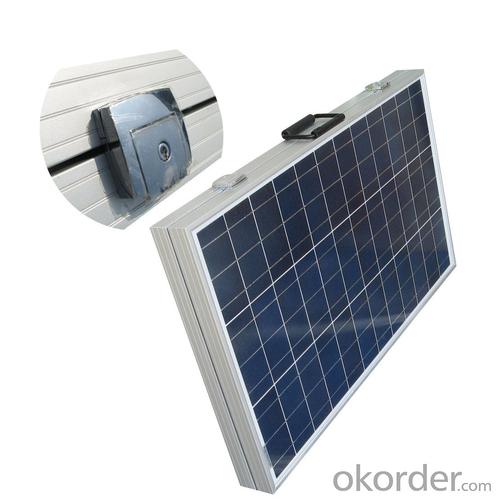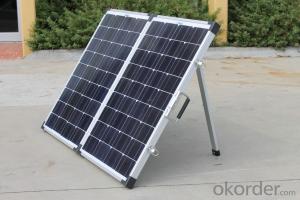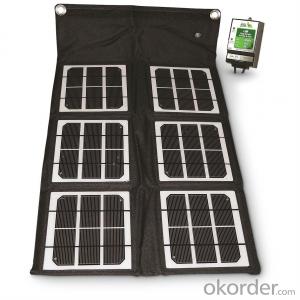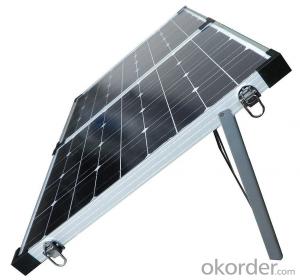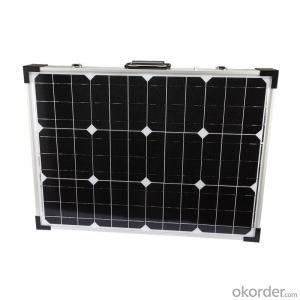Sells Solar Panels:130W Folding Solar Panel with Flexible Supporting Legs for Camping
- Loading Port:
- Shanghai
- Payment Terms:
- TT OR LC
- Min Order Qty:
- 1000 watt
- Supply Capability:
- 10000 watt/month
OKorder Service Pledge
OKorder Financial Service
You Might Also Like
Specification
Product Description
Folding module kits are designed to provide portable 12 volt power wherever you need it.PoPwer available from 20W to 240W
Features:
· Padded, moulded carry bag
· Heavy duty carry handle, hinges and clasps Stainless steel telescopic&adjustable legs
· Weatherproof solar charge controller with LED indicator
· 5m cable with heavy duty Anderson connectors between module-regulator & regulator-battery clamps
· All cabled up ready to use
· 2 year warranty
These kits are the ideal solution for 4WD, camping, caravaning, boating and recreational activities whereverpower is required for lights, small TV, camping fridge, pump or other small appliances.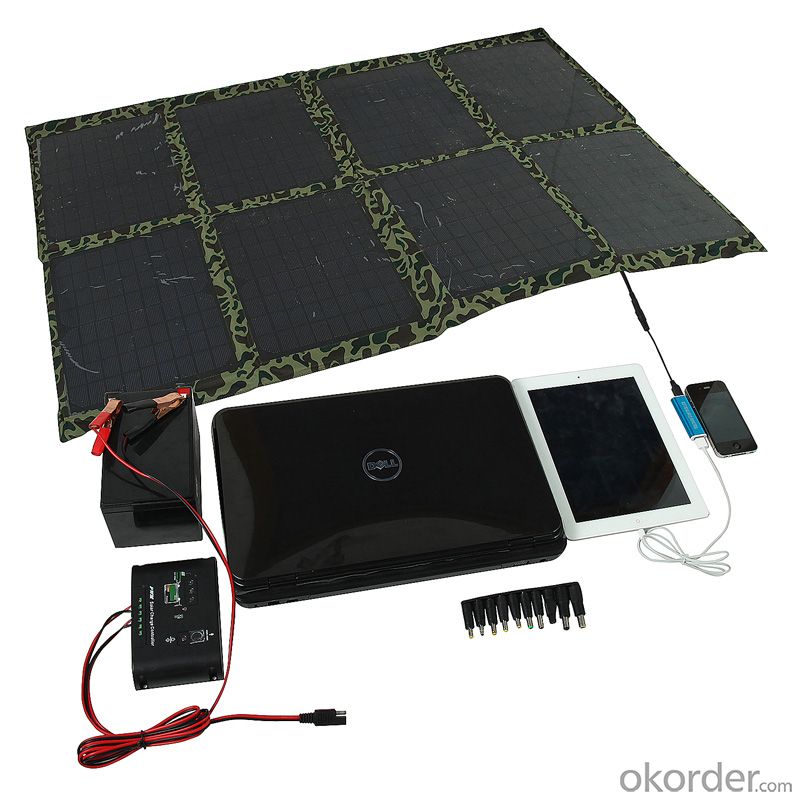
| Nominal Peak Power | 130W | 120W (2 x 60W) | 160W (2 x 80W) | 200W (2 x 100W) |
| Power tolerance | 3% | |||
| Cell type | Monocrystalline/Polycrystalline | |||
| Open circuit voltage (Voc) | 21.6V | |||
| Voltage at maximum power (Vmp) | 17.6V | 17.5V | 17.5V | 17.5V |
| Short circuit current (Isc) | 4.9A | 7.4A | 9.88A | 12.34A |
| Current at maximum power (Imp) | 4.54A | 6.86A | 9.14A | 11.42A |
| Maximum system voltage | 1000VDC | |||
| NOCT (Nominal Operating Cell Temperature) | 45 C +/-2 C | |||
| Operating temperature - module | -40 C to +85 C | |||
| Operating temperature – charge | -35 C to +55 C | |||
| Module folded size (mm) in carry bag | 505x550x60 | 505x825x80 | 505x1005x70 | 670x1005x70 |
| Module open size (mm) | 1014x550x30 | 1014x825x35 | 1014x1005x35 | 1344x1005x35 |
| Module net weight (kg) | 9.2 | 13 | 15.2 | 19 |
| Module gross weight (kg) | 11 | 16 | 19.4 | 23.2 |
| Solar charge controller | PWM 12V 10A; IP65 rated | PWM 12V 20A; IP65 rated | ||
- Q: What is the difference b/w them which one is better .
- these solar panels are named different based on the solar cells used... mono-crystalline solar cells: As the name suggests, each cell is made from a slice of a silicon crystal, which is made by purifying, melting and freezing silicon. pol-crystalline solar cells: these are a slight variation of single crystal solar cells. they are made of slices cut out of blocks of several silicon crystals, as opposed to single silicon crystals. check the link below to see other differences between the two types (easy to understand), such as their prices and efficiency levels. there is also a third type of solar cell/panel called amorphous solar cells.
- Q: Can solar panels be used during a power outage?
- No, solar panels cannot be used during a power outage unless they are connected to a battery storage system.
- Q: Do solar panels produce noise?
- No, solar panels do not produce noise as they generate electricity without any moving parts.
- Q: When you add a load resistor to a PV panel (Solar panel) of 00 ohms what happens to the voltage produced from the cellAlso, as the resistance increases, how does this affect the output voltage
- Look at the graph data that looks like a rotated L. That is what voltage as a function of current characteristically behaves. The highest voltage value is called open circuit voltage (Voc). The current at lowest voltage value is called short circuit current (Isc). If you notice, a second curve is plotted that looks like a hill. That curve is power output as a function of voltage. At the peak of said hill, you get the most utility of your PV module, as you output the maximum power possible, and that is the nameplate value for the PV module's power rating.
- Q: Can solar panels be used for powering a theme park or amusement park?
- Yes, solar panels can be used to power a theme park or amusement park. They can provide a sustainable and renewable source of energy to meet the power needs of various attractions, rides, and facilities within the park. By harnessing sunlight, solar panels can generate electricity that can be used directly or stored in batteries for later use. This not only reduces the park's carbon footprint but also helps to lower operational costs in the long run.
- Q: I am building a solar car for the energy wiz competition and I was wondering how I could possibly get my solar panel to shift sideways
- having solar panels move like that on a mobile platform is inadvisable -- especially if there is a dynamic wind load resulting from the motion of the mobile platform. Even having a tilt mechanism is dubious at best. think of what limited marginal gain would be gained by mounting a small solar panel on the moon roof of a car. (ultimately, the best answer is to turn the car so that it's angle to the sun is optimal -- but the road/travel direction constraints are what ultimately prohibit that.) while there are ways to build sliding panels, the weight constraints would interfere with your weight/thrust ratios to the point of futility. if you really need that panel somewhere else, don't slide it out of the way, just buy another panel and mount it there. it's more expensive, but it's actually the cheapest solution in terms of design on a mobile platform.
- Q: I have to show in a project (a model house) how Solar Panels work. In my model I want to show Solar Panels creating electricity to power a T.V but I need to show how the power gets from the Solar Panels to the T.V. A diagram would be really helpful. Please try and make this as simple as possible as I'm only 3, but try and be specific as well!
- solar panels are made of solar cells.Solar cells are mainly made of a semiconductor called silicon,when sunshine on it,solar energy is converted into electrical energy by photovoltaic.The energy knocks electrons loose, allowing them to flow freely.This flow of electrons is a current, this current, together with the cell's voltage (which is a result of its built-in electric field or fields), defines the power (or wattage) that the solar cell can produce.
- Q: How do solar panels generate electricity?
- Solar panels generate electricity through the photovoltaic effect, where sunlight is converted into electricity. When sunlight hits the solar panels, the photons in the sunlight knock electrons loose from their atoms, generating an electric current. This current is then captured and converted into usable electricity for powering homes and businesses.
- Q: Can solar panels be used in areas with frequent lightning storms?
- Yes, solar panels can be used in areas with frequent lightning storms. However, it is important to install proper lightning protection measures to ensure the safety of the solar panel system. This may include grounding the panels and using surge protectors or lightning arresters to divert the electrical charge from lightning strikes.
- Q: I have a 2V .5W solar panel and I want to get a battery that can be charged by the solar panel that can then be used to power a 2V .5W fan. Ideally I want all the components to be connected and able to run without interaction. I have very little knowledge in regards to this field which is why I have come to yahoo answers. Any help would be greatly appreciated.
- .5 Watt Solar Panel
Send your message to us
Sells Solar Panels:130W Folding Solar Panel with Flexible Supporting Legs for Camping
- Loading Port:
- Shanghai
- Payment Terms:
- TT OR LC
- Min Order Qty:
- 1000 watt
- Supply Capability:
- 10000 watt/month
OKorder Service Pledge
OKorder Financial Service
Similar products
Hot products
Hot Searches
Related keywords



